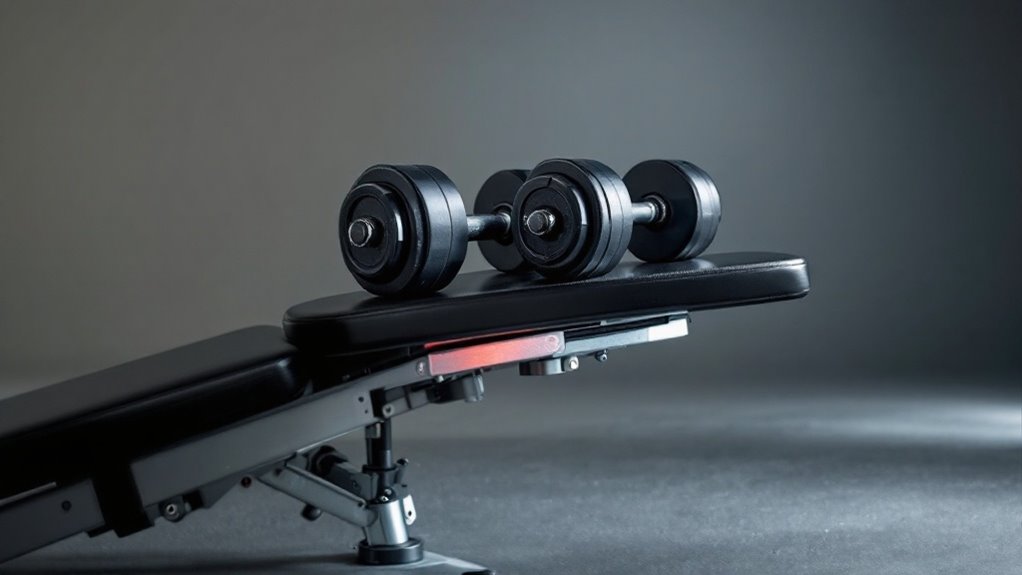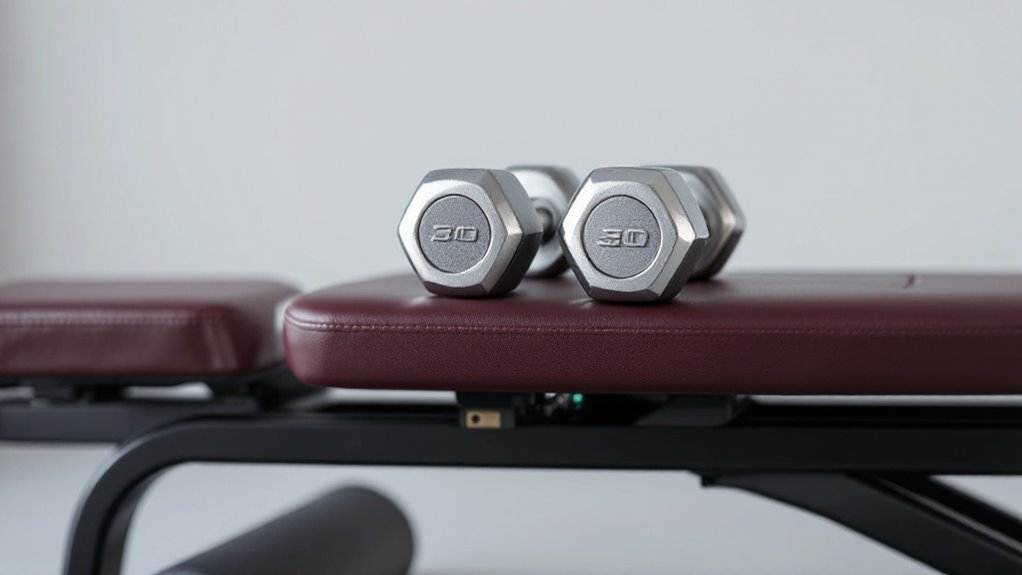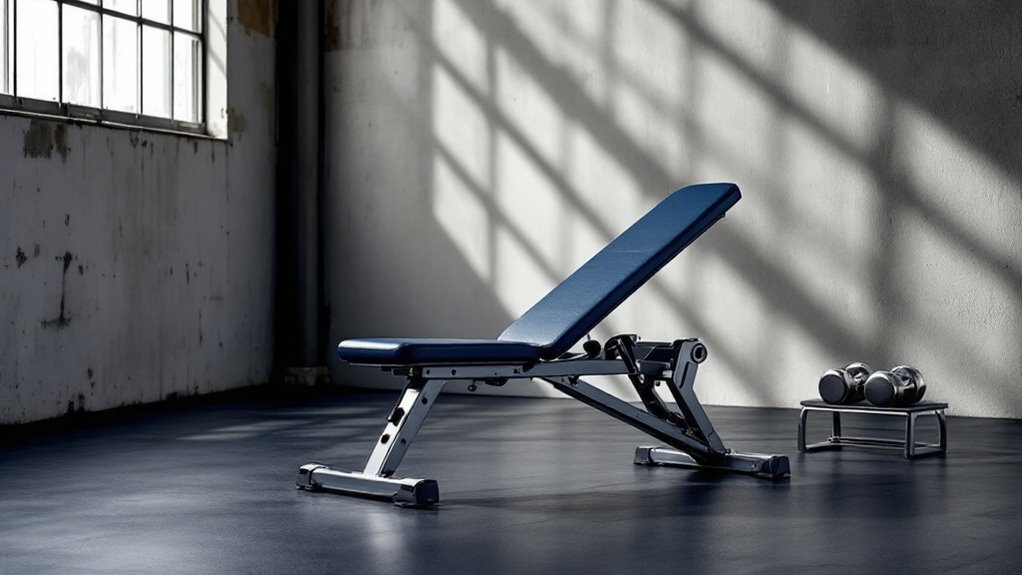Dumbbell Incline Chest Press

The dumbbell incline chest press is a powerful compound movement targeting the upper pectoralis major, anterior deltoids, and triceps. Performed on a bench set to 30 degrees, this exercise develops superior chest definition while enhancing functional strength. Proper form requires scapular retraction, core bracing, and controlled movement patterns with neutral wrists. The exercise offers unique benefits over barbell variations, including better range of motion and muscle balance. Mastering this foundational movement opens up advanced training possibilities.
Key Takeaways
- Set the bench at a 30-degree angle and retract your shoulder blades for optimal upper chest muscle activation.
- Press dumbbells up in a controlled motion while maintaining neutral wrists and avoiding full lockout at the top.
- Keep feet flat, shoulders pinned, and core braced throughout the movement for proper stabilization.
- Target muscles include the upper portion of pectoralis major, anterior deltoids, and triceps.
- Start with lighter weights to master form and gradually increase load for continued strength development.
Muscles Worked and Exercise Benefits

The dumbbell incline chest press stands as a cornerstone upper body exercise, targeting multiple muscle groups while delivering exceptional benefits for strength and aesthetics.
The movement primarily involves the upper portion of the pectoralis major, with significant assistance from the anterior deltoids and triceps during the pressing motion. A 30-degree incline provides optimal activation of the upper chest muscles. Proper bench support and foot placement are essential for maximizing chest engagement and maintaining stability throughout the movement.
The incline press maximizes upper pectoral engagement while recruiting the front deltoids and triceps for a comprehensive pressing movement.
Beyond muscle activation, this exercise offers distinct advantages for athletic performance and functional strength. Controlled breathing patterns enhance stability and power output during each repetition.
The controlled movement pattern improves upper chest development while enhancing overhead activities like sports throws and everyday tasks.
Furthermore, the dumbbell variation forces equal load distribution, preventing muscular imbalances and allowing deeper range of motion compared to barbell alternatives.
Proper Form and Technique

Mastering proper form and technique amplifies the effectiveness of the dumbbell incline chest press while minimizing injury risk.
Setting the bench at a 30-degree angle creates ideal upper chest activation without overdoing shoulder involvement. This position targets upper pectorals more effectively than flat bench variations. Start with lighter weights to master proper technique before progressing to heavier loads.
Proper execution begins with scapular retraction and core bracing. The dumbbells should lower to mid-upper chest level with elbows at 45-60 degrees. Maintaining neutral wrists and avoiding full lockout keeps tension on the chest muscles throughout the movement. Progressive overload principles help women steadily build upper body strength over time.
Key stabilization points include keeping feet flat on the floor, knees in line with hips, and shoulders pinned to the bench.
Control the weight through a complete range of motion while exhaling forcefully during the pressing phase.
Common Mistakes and Safety Tips

Spotting and correcting common mistakes during the dumbbell incline chest press proves essential for maximizing muscle development and preventing injury.
Common errors include using a wide arm path that reduces chest activation, allowing shoulder protraction that redirects work to the deltoids, and setting the bench angle too high above 30 degrees. Setting a bench angle between 15 to 30 degrees provides optimal upper chest activation. Implementing progressive overload gradually helps build strength while maintaining proper form.
Avoid wide arm paths, shoulder rounding, and excessive bench angles to ensure proper chest muscle engagement during incline presses.
Additional mistakes involve touching dumbbells together at the top, which eliminates tension, and inward forearm twisting that involves triceps over chest muscles. Exercises like extending over a foam roller can help prepare the chest for proper engagement.
To maintain safety, focus on controlled eccentric lowering, keeping the rib cage raised, maintaining proper palm orientation, and avoiding shoulder flaring through consistent shoulder blade retraction.
Advanced Training Variations

After mastering proper form and technique, lifters can progress to advanced variations that intensify the dumbbell incline chest press.
One powerful method is unilateral pressing, where each side works independently. This variation not only addresses muscle imbalances but allows for heavier loads per side compared to standard bilateral pressing. Setting the bench between 30 to 45 degrees creates optimal upper chest activation during these movements.
For maximum benefit, athletes can incorporate alternating presses, which stimulate core muscles and obliques for improved stability. A 15-degree incline is optimal for targeting the chest muscles effectively while maintaining proper shoulder position. Regular progressive overload helps ensure continued muscle development and strength gains.
The unilateral focus helps identify and correct strength discrepancies between sides while developing the triceps. This advanced technique demands strict form and controlled movement to prevent compensation patterns.
Frequently Asked Questions
How Long Should I Rest Between Sets of Incline Dumbbell Press?
Rest periods between sets should be 2.5-3 minutes for ideal muscle growth when working in the 8-12 rep range.
For strength-focused training with heavier weights and lower reps (3-5), extend rest to 4-5 minutes.
For endurance work with lighter weights and higher reps (12-20), reduce rest to 1-2 minutes.
These intervals enhance recovery while maintaining workout intensity.
Can I Do Incline Dumbbell Press Twice per Week?
Like a well-oiled machine running on two powerful cylinders, training twice per week creates ideal conditions for muscle growth and strength gains.
Research supports biweekly training frequency, provided there's a minimum 48-hour recovery window between sessions.
The key is managing volume and intensity – limiting to 2-3 exercises per session with 3-4 sets each while maintaining proper form and technique throughout.
Should I Use a Spotter When Performing Incline Dumbbell Press?
Using a spotter during incline press provides essential safety benefits and performance advantages.
They assist with initial dumbbell positioning, prevent accidents during fatigue, and enable training closer to muscular failure.
A spotter helps maintain proper form by monitoring back positioning and arm angles while providing verbal cues.
For beginners, heavier loads, or when pushing intensity limits, having a spotter is strongly recommended.
Is Incline Dumbbell Press Better in Morning or Evening Workouts?
Powerfully performing press movements proves particularly productive during evening sessions.
The body's natural circadian rhythm supports peak strength and muscle activation later in the day, with ideal body temperature and hormonal levels.
However, morning workouts can still deliver excellent results when consistent technique and proper warm-up protocols are followed.
Individual preference and schedule compatibility should ultimately guide timing selection.
What Weight Dumbbells Should Beginners Start With for Incline Press?
Beginners should start with 5-15 pound dumbbells, focusing on proper form and muscle activation over heavy weight.
Women typically begin with 5-8 pounds, while men often start with 10-15 pounds.
The key is mastering controlled movements through 6-12 repetitions before increasing load.
Starting too heavy compromises form and risks injury.
Progress gradually as strength and technique improve.
Final Thoughts
The dumbbell incline chest press stands as a cornerstone movement for upper body development and functional strength. While some may find their journey to mastery challenging at first, proper form and consistent practice pave the way to impressive results. By incorporating variations and heeding safety guidelines, this exercise can transform an average chest workout into an extraordinary upper body improvement experience.


